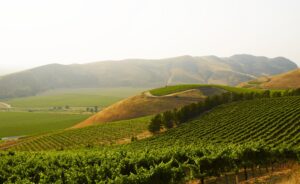Wines come from and are known by certain regions. They are AVAs in the United States, AOCs in France, DOCGs in Italy, etc. In each one of those regions, there are many vineyards, some clearly better than others. Knowing which ones are the best can lead to greater pleasure when you go wine tasting. That sounds simple, but it gets more confusing depending on which sector of Wine Country you are visiting and how they allocate the land.
Bien Nacido Vineyards in Santa Maria, California. Photo courtesy of biennacidoestate.com.
- In Bordeaux, it’s easy. The rules there are that all the grapes in a wine identified with a specific chateau or domain must be grown on its property. If you see a wine simply called a Bordeaux on the label, it can be from anywhere in the region.
- In Burgundy, it’s difficult. In many cases, growers don’t own vineyards, they own parcels or even individual rows of grapes, within identified vineyards. And those may be villages, premier cru or grand cru depending on the terroirs of each. So wines made from grapes grown in certain well-known vineyards such as Chambertin or Clos de Vougeot are the ones you should look for.
- In California, things can get a little tricky, too. Many wineries boast of their “Estate” or “Estate Grown” wines. That means that the grapes for those wines came from the producer’s own property, were cultivated by its own staff and were vinified on the premises as well. It doesn’t mean that the grapes are necessarily the ones you can see out the tasting room window. They can come from anywhere in the AVA that’s indicated on the bottle.
- But not all wines are “Estate”. Many wineries make wine but don’t do the farming themselves. (And many wineries that do have Estate wines also make wine from purchased grapes.) When you are sampling a wine that isn’t Estate, it’s fair to ask which vineyards the grapes come from. There are some so highly regarded that the name of the vineyard alone is enough to make a taste desirable.
- For example, in Napa Valley, Beckstoffer is the acknowledged leader. And within Beckstoffer’s properties there’s the To Kalon, made justly famous by Robert Mondavi. Morisoli in the Rutherford Bench is also well reputed, as is Stagecoach high up on the mountains to Napa Valley’s east.
- To confuse matters further, some growers sell most of their grapes and also make their own wines. So, for example, Truchard and Baciagalupi are major sources for many wineries. The former’s wide variety of grapes, especially Chardonnay, can be found in many wines around Napa. Baciagalupi in Russian River grows Pinot Noir and Chardonnay for many other wineries.
- Further south, look for any wine made from grapes from the Bien Nacido vineyard. In the Central Coast, many wineries boast their wines from that vineyard, with Au Bon Climat claiming the largest share.
- And in the Santa Barbara area, Sanford and Fiddlestix vineyards have great reputations. Sanford also makes wines under their own name, while Etude (among others) makes a Fiddlestix Pinot Noir.
